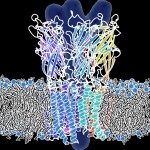Link to Pubmed [PMID] – 19502493
Link to HAL – Click here
Link to DOI – 10.1093/nar/gkp460
Nucleic Acids Res. 2009 Aug;37(14):4642-56
Terminal deoxynucleotidyltransferase (Tdt) and DNA polymerase mu (pol mu) are two eukaryotic highly similar proteins involved in DNA processing and repair. Despite their high sequence identity, they differ widely in their activity: pol mu has a templated polymerase activity, whereas Tdt has a non-templated one. Loop1, first described when the Tdt structure was solved, has been invoked as the major structural determinant of this difference. Here we describe attempts to transform Tdt into pol mu with the minimal number of mutations in and around Loop1. First we describe the effect of mutations on six different positions chosen to destabilize Tdt Loop1 structure, either by alanine substitution or by deletion; they result at most in a reduction of Tdt activity, but adding Co(++) restores most of this Tdt activity. However, a deletion of the entire Loop1 as in pol lambda does confer a limited template-dependent polymerase behavior to Tdt while a chimera bearing an extended pol mu Loop1 reproduces pol mu behavior. Finally, 16 additional substitutions are reported, targeted at the two so-called ‘sequence determinant’ regions located just after Loop1 or underneath. Among them, the single-point mutant F401A displays a sequence-specific replicative polymerase phenotype that is stable upon Co(++) addition. These results are discussed in light of the available crystal structures.


